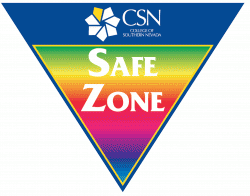Welcome to the CSN Safe Zone website! The CSN Safe Zone Program is designed to promote a more welcoming, safe, and inclusive environment for members of the LGBTQ communities and to educate and promote understanding, appreciation and respect. It includes training, the formation of an ally program with identified Safe Zones throughout the college campuses, and information and resources available at various locations, including Safe Zone spaces, a Safe Zone web portal, and targeted events and activities.
College of Southern Nevada faculty and staff can register for future training classes by
visiting the Center for Academic & Professional Excellence (CAPE) website.
Safe Zone 101 – 2 hours
| Safe Zone 102 – 2 hours
|
|---|
Community Resources
Henderson Campus - Safe Zone Allies
A safe zone or a safe space is a confidential place where all people can bring their authentic selves and feel safe, welcome and included. It may be a classroom, a car or an entire agency. Creating safe zones or safe spaces is a proactive step that schools, agencies and corporations can take to create welcoming, inclusive spaces so that all people are empowered to reach their full potential.
While progress is slowly being made to create more welcoming and inclusive workplaces for LGBTQ employees, there is still much to be done. Below are some eye-opening statistics from the 2014 Human Rights Campaign’s The Cost of the Closet, a national study examining workplace climate for LGBTQ employees.
- 62% of LGBTQ employees report hearing jokes about lesbians and gays in the workplace.
- 53% of LGBTQ employees hide who they are at work.
- 20% of LGBTQ employees report looking for another job specifically because their workplace environment wasn’t accepting of LGBTQ individuals.
For many LGBTQ individuals energy that could be spent on working and creating healthy relationships with coworkers is instead spent on maintaining barriers, avoiding social events and learning how to keep secrets about their home lives and families.
